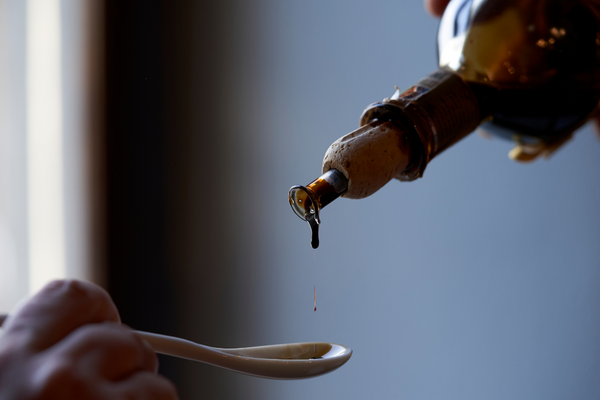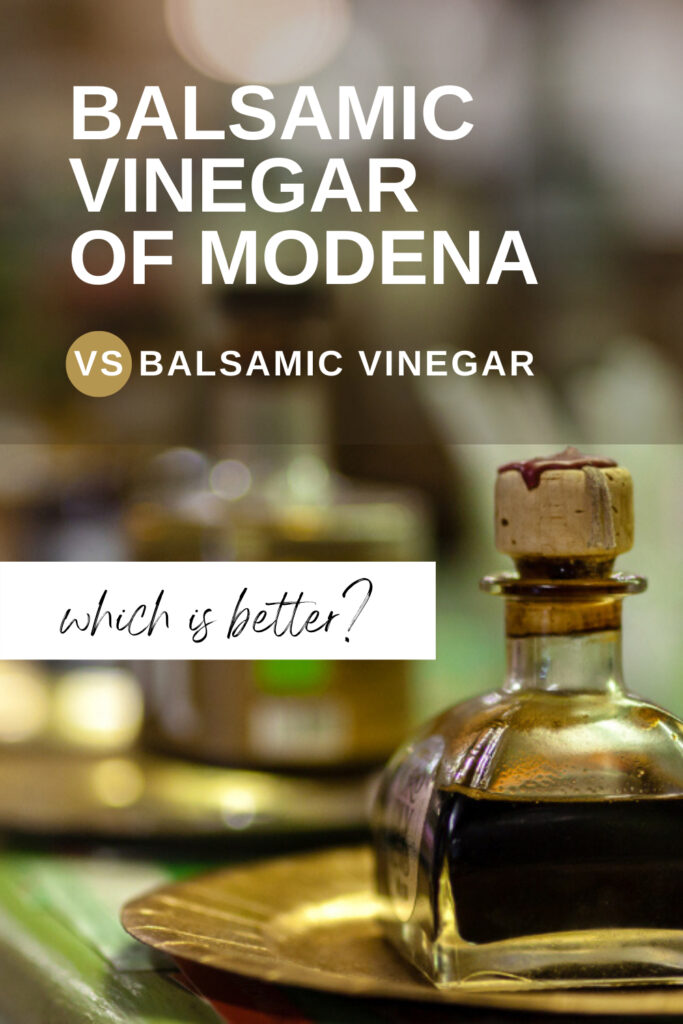If there’s one thing we can probably all agree on is that balsamic vinegar is a delicious condiment, especially when it comes to Italian cuisine. You might have one or two go-to balsamic vinegars that you use and love, maybe one of them is a Modena balsamic vinegar, but you probably can’t understand the difference between Balsamic vinegar of Modena vs Balsamic Vinegar. Let’s discuss this and clarify it together.

It’s best to start by defining balsamic vinegar. Wikipedia defines it as follows:
‘Balsamic vinegar (in Italian: aceto balsamico) is a very dark, concentrated and intensely flavoured vinegar originating in Italy, made wholly or partially from grape must: freshly crushed grape juice with all the skins, seeds and stems.’
You probably also heard that balsamic vinegar’s key characteristic is that it’s matured in large wooden barrels, and that’s true. The longer is left to mature the tastier it becomes.
Balsamic vinegar is just one type of vinegar, though. There are so many others – from the simple white wine vinegar to the trending apple cider vinegar. Each is derived from a different key ingredient – which in the case of apple cider vinegar is apples, whereas for rice vinegar is fermented rice.
Balsamic vinegar, like white wine vinegar, is made from you guessed it.. grapes. However, don’t confuse white wine vinegar with white vinegar, which is derived from alcohol and it’s usually used in cleaning. If distilled, the latter is also used for pickling.
Back to balsamic vinegar now. If both balsamic vinegar and white wine vinegar are made from grapes, what’s the difference then?
The first thing you can quickly notice is the colour. Balsamic vinegar is usually dark, although there are white balsamic vinegars, whereas white wine vinegar is very light. Why is that? Contrary to what you might think, the reason why balsamic vinegar is dark is not that it’s made from red grapes.

Unlike white wine vinegar, which is made from white grapes, balsamic vinegar can be made from both white and red grapes. The most common grapes used are Trebbiano, Lambrusco, and Ancellotta.
The difference in colour is the result of how balsamic vinegar is made, which is by heating the juice of pressed grapes until a must is obtained. The must has a dark colour because during the heating the grapes juice caramelizes; I am sure you are familiar with the dark colour of caramelised sugar. On the other hand, when making wine vinegar – both white and red – there’s no cooking involved. White or red wine vinegar is made from fermenting the grapes juice or wine.
Another important difference is the taste. Balsamic vinegar has a sweeter more harmonious and elegant taste, while white wine vinegar is more pungent.
The most important difference is the use. White wine vinegar is used in salads and with fish, and is a great vinegar for pickling. If you like to put vinegar on your food to give it more flavour, then you should use balsamic vinegar.

Balsamic vinegar can be used to add flavour to both raw foods and cooked ones. You can also use it in your cooking: in pasta (check this balsamic red sauce pasta), fish recipes (here’s a delicious Mediterranean salmon with balsamic), on vegetables (try these tasty balsamic roasted vegetables), with chicken and meats. Don’t forget to use your balsamic vinegar in desserts from crumbles to little pastries, and even ice cream.
Browse desserts with balsamic vinegar here.
Now that we have clarified what balsamic vinegar is, how it differs from other vinegars, and how we can use it to make our food tastier, we can now speak about Balsamic vinegar of Modena.
The regulations on balsamic vinegar are not clear. What is clear is that while some form of balsamic vinegar was already used in ancient Babylonia, modern balsamic vinegar came from Italy. Although the Romans discovered the recipe, the latter was perfected in Emilia Romagna. It was also here that the ‘balsamic vinegar’ term was coined. The latter appeared first in 1747 on the logs of the Dukes of Este’ s cellars. Back then, the Este Family ruled the Duchy of Ferrara, which included both Modena and Reggio.
Even though balsamic vinegar’s traditional recipe originates from Italy other countries can still use the term balsamic vinegar. So you can find French balsamic vinegar as well as Greek balsamic vinegar, and so on.
Other countries can’t, however, use the terms Modena and Reggio because these are protected, along with these three types of Italian balsamic vinegars:
Traditional Balsamic Vinegar of Modena PDO (buy our finest here)
Traditional Balsamic Vinegar of Reggio Emilia PDO
Balsamic Vinegar of Modena PGI (buy our bestseller here)
The difference between the 3 protected balsamic vinegars above is that the first two only include grape must, whereas the third also includes some white wine vinegar. All of them are delicious but the first two are more expensive and pure.
You might also be asking yourself what’s the difference between Traditional Balsamic Vinegar of Modena and that of Reggio Emilia. The only difference is the location of production.

First of all, let me tell you that most balsamic vinegars on the market are Italian. Secondly, I might be biased but in my opinion nothing beats the taste of an Italian Balsamic Vinegar, PDO or PGI. My advice to anyone that asks this is to try everything that is available, and choose for yourself. I am pretty confident though that once you taste one of our Italian balsamic vinegars of Modena, you won’t feel the need to look elsewhere.
You can shop Traditional Balsamic Vinegar of Modena PDO here, or try the lowest priced Balsamic Vinegar of Modena PGI, which is our bestseller. Once you try them both you can find out the difference, and most importantly determine which one you like the most.
Usually, you would want to keep the lowest price in your condiment cupboard to use it all the time, while you might leave the more expensive one for those special occasions. That’s ultimately your choice, and one that depends on budget, preference, and use.